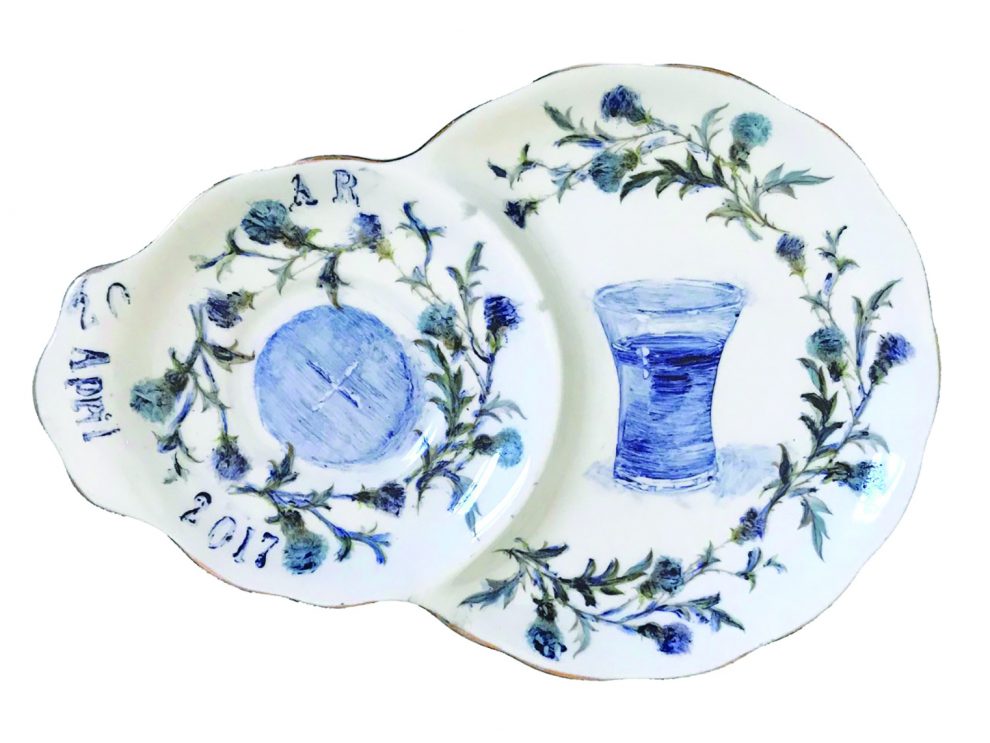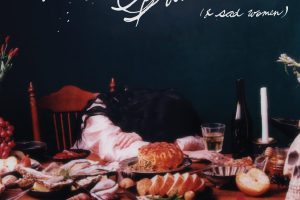What does Eucharist call us to be? How does Eucharist shape our lives? Scripture scholar and Blessed Sacrament Father Eugene LaVerdiere wrote an influential book with the evocative title Dining in the Kingdom of God (Liturgy Training Publications) in which he explores Jesus’ meal ministry and proclamation of the kingdom of God in the Gospel of Luke. The eucharistic message is clear: The Eucharist is not simply a thing to be worshipped or consumed but an action powerfully linked to God’s transformative presence in our world. Eucharist calls us to work toward building the kingdom of God, especially in areas where we encounter suffering and injustice. But how often do we see eucharistic art that witnesses to a true encounter with the prophetic Christ and the kingdom he proclaimed?
Communion
Julie Green
We can find one such profound instance of this in an ongoing series titled The Last Supper by Julie Green. For more than 20 years Green has been memorializing the last supper requests of prisoners on death row in an artistic act that protests the death penalty. The food
requests are profoundly personal. They reveal a life history, unique taste preferences, and memories of what was once good about life. They humanize the moment and make the person present while at the same time they reveal an absence. These empty plates remind us that through the persistence of capital punishment we are still far from realizing the kingdom of God that Jesus proclaimed. Yet these plates also point to the possibility of communion and redemption.
One such powerful example is of an exceptional meal request titled Communion. This artwork depicts two overlapping plates ornately decorated with intertwining flowers. In their centers, painted in brushy blue, are a cup and a host. We may be reminded here that Jesus, after his last supper, was executed with criminals, one of whom repented. To that criminal Jesus offered communion and the kingdom. Do we do the same?
On more than one occasion, Pope Francis has stated that he opposes the death penalty, partially because he believes it robs people of the opportunity for repentance and redemption. This painting not only highlights this possibility but also challenges us to recognize with whom we share the Eucharist. Are we truly in solidarity with the convicted criminal with whom we are united in this
sacred meal?
Thank God I’m Home said Marcel Brown
Julie Green
More recently Green has expanded her series to include “first supper” images. These show the first meals of prisoners who have been exonerated. Here again faith looms large. One striking image depicts a corned beef sandwich in the foreground and a church-like house in the background. Emblazoned across its surface are the words spoken by the exonerated man: “Thank God I’m home.” If our Eucharists are to be truly a foretaste of the kingdom, then this “first supper” witnesses to God’s liberating love and the hard work of those who help free the wrongly accused. This sense of joy, gratitude, and liberating love should also be at the heart of our Eucharists. Green’s plates are a call to action. They remind us of what Eucharist calls us to be.
Trinity
Scott Erickson
Eucharist as a window into the life of the divine is something the icon tradition has long excelled at conveying. In this regard, Andrei Rublev’s famous icon of the Trinity easily comes to mind. Scott Erickson’s series titled New Icons opens this up in thought-provoking ways with his dynamic print titled Trinity.
Like in Rublev’s icon, Erickson’s Trinity presents three persons sitting at a table. Unlike Rublev’s subjects, however, these figures’ faces are hidden. While they’re clearly human in “image” and “likeness” (Gen. 1:26), their faces are obscured, giving us the ability to see God as both personal and transcendently other. Another deft choice in this regard is the stylization of the figures’ garments. Their large, flowing forms keep us from identifying male or female traits. Thus, everyone can see themselves in these divine figures. Yet Christ’s wounded hands still reveal his sacrifice and post-resurrection identity. We also recognize the Spirit through a feather-patterned cloak.
Importantly, as in Rublev’s icon, hospitality is a central message of this artwork, and it’s profoundly generous and selfless. We see this unfold
in a number of ways. Each person fills not their own cup but the cup of the person next to them. These are abundant cups! The figures pour generously and freely without any concern of overflowing. The three chalice-like cups then come together at their bases, overlapping like a Venn diagram, echoing the unity and uniqueness of each person of the Trinity. This print is an inspiring example of what our Eucharists could be. It’s a vision of mutuality and graciousness. It shows a Eucharist that witnesses to the hospitality, communion, and abundant love in the heart of God’s inner life, and it is a model for us all.
Emmaus
Emmanuel Garibay
Eucharist is life-giving, yet eucharistic art can often be overly solemn and weighty. This is not so in Emmanuel Garibay’s euphoric masterpiece Emmaus. Other famous paintings that depict this scene from Luke’s gospel convey the surprise of this revelatory eucharistic moment (for example, Caravaggio’s Supper at Emmaus or Arcabas’ Emmaus). But Garibay’s Emmaus is unique in conveying not only the real surprise but the wonderful delight and joy of this “breaking of the bread.”
Here we encounter warm, inviting colors. Gesticulative, elongated arms with enlarged, expressive hands enhance the mood of surprise and wonder. A swinging light bulb and an upturned table prepare us for the upturning of expectations. Garibay employs a classical artistic device, using a finger to point to a key element within the painting: the nail marks in Christ’s hands. The moment is captured like the delivery of a perfectly timed punch line. Red-cheeked laughter ensues with looks of recognition and delight.
The sight of Jesus as not only resurrected but also female is truly “eye-opening.” It’s not met with fear or resistance but with laughter and joy—as if to say God is filled with surprises! Observe also that this looks like a gathering of friends, people who actually know and like each other. Garibay’s Emmaus meal portrays a Eucharist that not only brings healing to a community that is suffering the loss of its beloved spiritual leader but offers a life-giving future unlike anything they imagined. As in the words of the prophet Isaiah, “I am about to do a new thing; now it springs forth, do you not perceive it?” (Isa. 43:19). Are our Eucharists open to God doing something new?
Zero Hunger
Emmanuel Jarus
How do we end hunger and food insecurity? This lofty goal is inspiring a series of murals around the world in honor of the 75th anniversary of the United Nations and its goal to end world hunger by 2030. This mural by artist Emmanuel Jarus is striking for what it is and what it isn’t. Instead of seeing a heart-wrenching image of a starving child on the brink of death, we see an image of hope bathed in gentle light. A young Asian child is shown reaching for a piece of fruit. The boy looks up in earnest. Nourishment is within his reach, provided by nature. Anyone happening upon this scene would likely empathize with the child, hoping he satisfies his hunger. In fact, many would likely wish they could help the boy.
What has this to do with Eucharist? Well, imagine that after receiving the Eucharist and being sent forth, you were to see this mural on your way home. What would you think? Eucharist isn’t simply to nourish us but to strengthen us to nourish our world and continue Jesus’ work of building the kingdom. This entails not just responding to the spiritual hungers of humanity but the physical hungers as well. This is a work of charity and justice, because a world that allows people to starve, especially the most vulnerable, is systematically flawed and sinful.
The Dove
Ioan Chisu
Eucharist is inexhaustible, and eucharistic art should likewise have inexhaustible expressions. Many of us seek the peace that only Eucharist can bring. We gather around the eucharistic table to experience the peace of the body of Christ in our midst in a myriad of ways. Ioan Chisu’s meditative yet dynamic abstract painting The Dove presents us with such an opportunity.
Here we discern a flat, almost minimalist altar. Contemplative grays and cool blues add an air of thoughtful calm. An unadorned chalice attracts the eye with its circular, host-like form elevated above. A geometric design in white and black evokes a piano key and its concomitant music note as an abstract dove crosses the plane of vision surrounded in warm, vivid blue. These subtle converging elements present the viewer with a liturgical evocation of epiclesis: the Holy Spirit’s grace-filled action making true Jesus’ promise to be present once again in the breaking of the bread. Chisu’s painting has a musicality that comes with maturity, expressing exactly what needs to be said, no more and no less.
There is life-giving peace here for an all-too-troubled, confusing world. There is clarity without the loss of holy mystery. We need this reassuring aspect of Eucharist as well. Eucharist “ever ancient and ever new,” to borrow from St. Augustine. Eucharist as Christ’s abiding presence.
This article also appears in the May 2021 issue of U.S. Catholic (Vol. 86, No. 5, pages 10-15). Click here to subscribe to the magazine.
Image: Upfor Gallery / The Last Supper, Julie Green: Arkansas 20 April 2017: Communion. 6 x 9 inch platter, one from a series of 895 painted and kiln-fired ceramic plates of final meals, 2018 (began series in 1998). The Last Supper series is on view at Bellevue Arts Museum through fall 2021.














Add comment